Genesis of a Soviet “land battleship”
Work started in 1930 on the future T-35 at the OKMO design bureau of the Bolshevik Factory on a heavy tank project for the Red Army. Two projects were initially proposed, one from the German-born engineer Grotte as the 100-ton monster G-5, and the other, a more “reasonable” 30-tons+ heavy tank designed by N. Tsiets. Both were multi-turreted, just like the other European projects of the time, particularly the British A1E1 Independent. By July 1932 the prototype was completed. Instead of the naval gun planned, it was armed with a regular 76.2 mm (3 in) standard field gun and about 35 tons in weight, hence the T-35 of the production model. This prototype had two turrets with 37 mm (1.46 in) guns and two others with machine guns. The transmission was brand new and had multiple teething issues. Furthermore, it was judged to complex for production, and a second prototype was built.
T-35 final Design
To ease mass-production and commonality, engineers choose to pick up as many elements from the medium tank T-28 they could . It had the same engine, transmission, main turret and secondary turrets, but had a custom suspension and unique roadwheels and bogies. The hull and turret armored plates were assembled by welding and riveting. The hull front was 30 mm (1.18 in) thich, while the turret was 20 mm (0.79 in) thick, just as the sides, that also had 10 mm (0.39 in) of side skirts. By 1936, the front plate was increased to 50 mm (1.97 in) by adding 20 mm (0.79 in) of appliqué armor, forming a beak, as well as redesigning the armored hatches of the driver and co-driver.
The main turret was similar to the T-28 model, and had an electro-mechanical three-speed drive traverse, with manual backup. The main gun was originally a 76.2 mm (3 in) gun KT obr.1927/32 adapted from the regimental field-gun obr.1927, later replaced by the KT-28 gun from the T-28, with a -7° and +23° depression/elevation. It had its own independent fire control system, comprising a standard telescopic breech-sight TOP obr.1930 and a periscope breech-sight PT-1 обр.1932. 96 rounds were in store in the turret, fighting compartment and hull below.
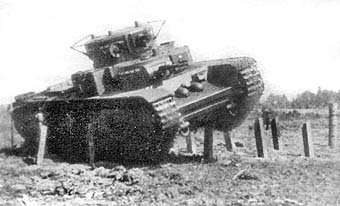
Contrary to the T-28, the secondary turret DT machine gun was mounted in a separate ball race. There was a spare one which could be fastened to the loop setting on the main turret storage niche, at the back. On the T-28 it was permanent, in a ball mount. A third one was optionally installed on an external P40 for AA defense in 1938.
The secondary turret arrangement was specific and perhaps inspired by battleship design. It was en échelon, with the main 45 mm (1.77 in) turrets and smaller 7.62 mm (0.3 in) light ones side by side around the central front and rear central bulkhead. The main turret towered above. The 45 mm (1.77 in) turrets had 225 rounds in store, and there was a total of 10,080 cartridges for the light DT machine guns.
The long drivetrain comprised eight bogies with two pairs of roadwheels each, a tensioner at the front, rear drive sprockets, front idlers, and no less than six return rollers per side. Side skirts composed of six armored panels were partially attached to the catwalk, the open space above acting as mud chutes. The T-35s were often seen with a “horseshoe” type antenna around the main turret. Although there is little info about the real proportion of commander versions, part of the tactics used possibly imposed that these vehicles could act “by default” as such. This was an old idea taking its roots in the “land battleship concept”, defended by Churchill when he was at the same time First Lord of the Admiralty and the head of the Landship Commitee. General Estienne advocated at the same time fleets composed of the super-heavy FCM C1 surrounded by light and nimble FTs. The multi-turret configuration, large size and high price of the T-35 was clearly mirroring the role of a battleship on land. Although it was not specifically designed as a breakthrough tank, there was clearly a place for it in the Soviet “deep battle” tactic.

T-35 on the Red Square, 1st May 1936 parade.
Production
By August, 11, 1933, the T-35 was standardized and accepted for production, taken up at the Kharkov Locomotive Factory. The final production design differed from the second prototype. The hull was lengthened, protection improved, and standard 45 mm (1.77 in) guns replaced the old 37 mm (1.46 in) with turrets similar to the BT-5 model, but without overhang. After a first series of two batches of ten, then 35 machines until 1938, a new model was developed, the T-35B or “model 1938”. It had sloped armored turrets of the new model, modified side skirts and new idler wheels. Six vehicles were built. These would be the last of the series. There was a project of fitting the L-10 gun but the GABTU (Auto-Tank Directorate) abandoned it. In fact the main gun was more intended to face concrete fortifications and other obstacles, while the secondary 45 mm (1.77 in) were meant to deal with tanks and the MG turrets with infantry.
The T-35 in action
The first T-35 were affected to the 5th Separate Heavy Tank Brigade in Moscow, and paraded on May, 1st, 1936 on the Red Square. They apparently did not participate in the border wars in Mongolia, the invasion of Poland or the Winter War. By June 1940, they were seen as nearly obsolete and costly to operate, and the question was raised of their demobilization, conversion, or assignation to military academies. They were eventually transferred to the 8th Mechanized Corp in the Kiev district (Ukraine), into the 67th and 68th Tank Regiments of the 34th Tank Division. In the summer of 1941, 90% of these tanks were lost due to mechanical breakdowns, lack of maintenance, fuel, and often sabotaged by their crews abandoning them.
These figures can be explained by its sheer size and the fact it was overweight for its engine and transmission (similar to the T-28). A few surviving vehicles were recorded during the battle of Moscow during the winter 1941-42. The Germans captured lots of them, one being sent to Kummersdorf for testing. Four machines were stored for training at the rear, and survived the war. One is now displayed at the Kubinka Museum and is apparently in “running condition”.
T-35 specification |
|
| Dimensions (L-w-h) | 9.72 x 3.20 x 3.43 m (31.8 ft x 10.4 ft x 11.2 ft) |
| Total weight, battle ready | 45 tons |
| Crew | 11 |
| Propulsion | 12 cyl 45L Mikulin M17, 500 bhp |
| Speed (road/off-road) | 30 km/h (18.6 mph) |
| Range | 150 km (93 mi) |
| Armament | Main: 76.2 mm (3 in) M27/32 gun (95 rounds) Sec: 2 x 45 mm (1.7 in) 20K HV guns (225 rounds) Sec: 6 x 7.62 mm (0.3 in) DT machine-guns (10,080 rounds) |
| Armor | 11 to 30 mm (0.4-1.18 in) |
| Total production | 61 |
Links
The T-35 on Wikipedia
Walkaround at the Kubinka musem
Reference 84 pages pdf document (in Russian)
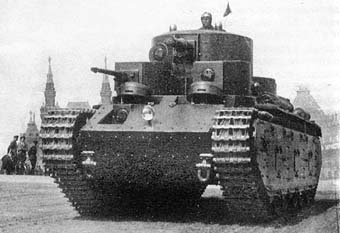
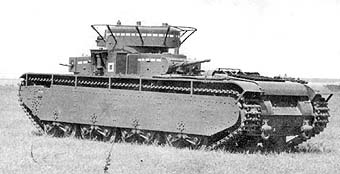



Credits: Wikimedia Commons
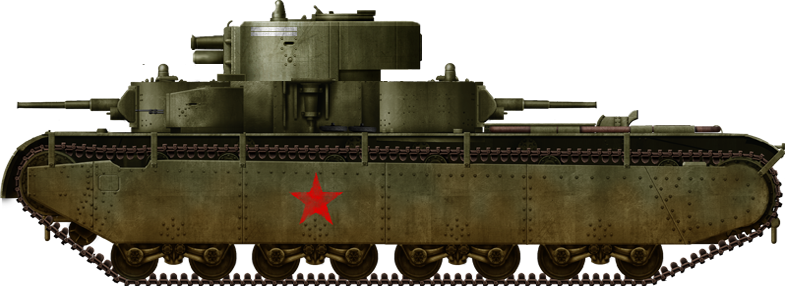
T-35A in 1936, training near Kharkov.
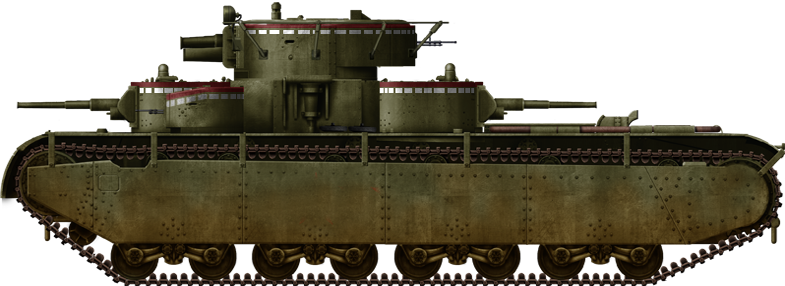
T-35A, 34th Tank Division, 8th Mechanized Tank Corps, June 1941.
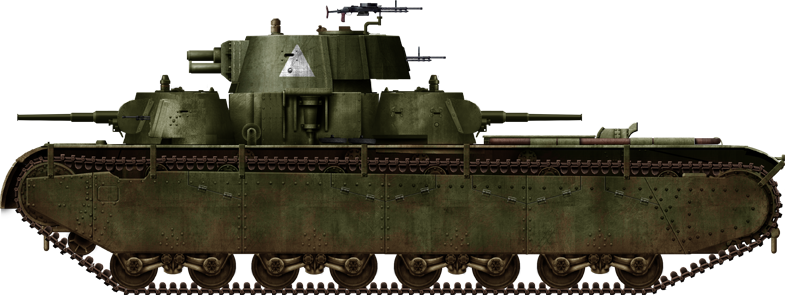
T-35B, 68th Tank Regiment, 34th armoured Division, July 1941.

WW2 Tanks




























WW2 tanks posters

All Tiger tanks liveries.

Panther liveries and variants

WW2 Armour - All tanks











Tanks aces and single tanks series

Find more there

Museums, Movies, Books & Games
The Tanks and Armor in pop culture
Tanks and armored vehicles in general are only really grasped when seen first person: The mass, the scale, it's all there. Explore also the way tanks were covered in the movie industry, in books and in video games.Movies:
Best tanks movie on warhistoryonline.com
On imdb.com
On bestsimilar.com/
miltours.com
liveabout.com/
watchmojo.com
Video Games:
pcgamesn.com
historyhit.com
levvvel.com
vg247.com/best-tank-games
mmobomb.com/
alienwarearena.com

